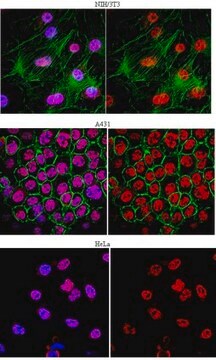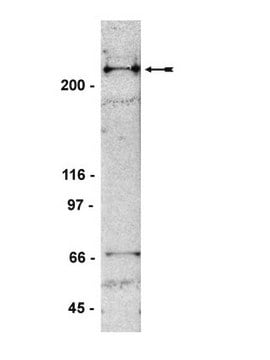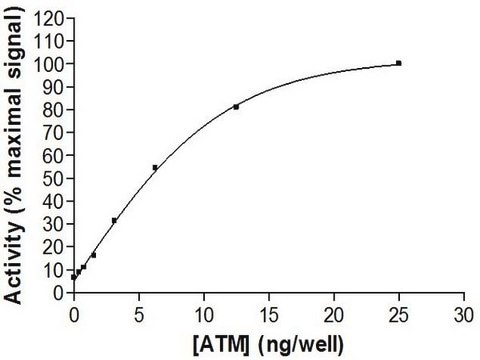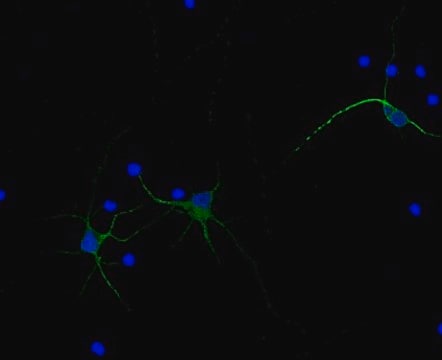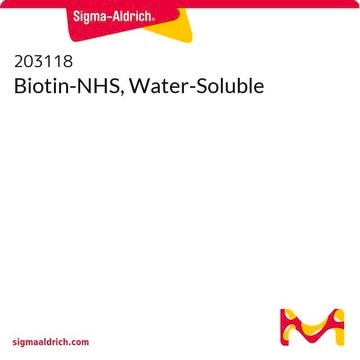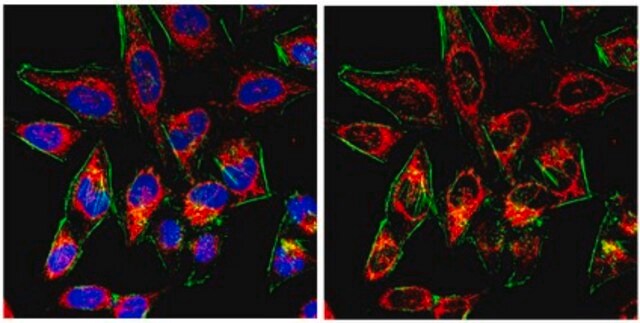05-1517
抗-hnRNP Q抗体,克隆18E4
clone 18E4, from mouse
别名:
heterogeneous nuclear ribonucleoprotein Q-like, Synaptotagmin-binding, cytoplasmic RNA-interacting protein, Glycine- and tyrosine-rich RNA-binding protein, GRY-RBP, NS1-associated protein 1
登录查看公司和协议定价
所有图片(1)
About This Item
分類程式碼代碼:
12352203
eCl@ss:
32160702
NACRES:
NA.41
推荐产品
生物源
mouse
品質等級
抗體表格
purified immunoglobulin
抗體產品種類
primary antibodies
無性繁殖
18E4, monoclonal
物種活性
human
技術
immunocytochemistry: suitable
immunoprecipitation (IP): suitable
western blot: suitable
NCBI登錄號
UniProt登錄號
運輸包裝
wet ice
目標翻譯後修改
unmodified
基因資訊
human ... SYNCRIP(10492)
一般說明
异质核核糖核蛋白Q通常称为hnRNP Q,是由单个基因的选择性剪接产生的三种不同亚型。这种RNA结合蛋白与运动神经元(SMN)蛋白存活的mRNA前体剪接控制有关。SMN的功能丧失突变与脊髓性肌萎缩症(SMA)有关,SMA是一种常见的神经退行性疾病。研究表明hnRNP Q蛋白可与SMN相互作用,这种相互作用是有效的体外pre-mRNA剪接所必需的。目前的研究表明hnRNP Q是SMN的剪接调制器。
特異性
该抗体可识别hnRNP Q。
免疫原
对应于人hnRNP Q的重组蛋白。
表位:未知
應用
使用在WB、ICC、IP中验证的抗-hnRNP Q抗体,克隆18E4(小鼠单克隆抗体)检测hnRNP Q,也称Q样异质核糖核蛋白。
免疫细胞化学
由独立研究人员使用代表性批次进行报道。
免疫沉淀
由独立研究人员使用代表性批次进行报道。
由独立研究人员使用代表性批次进行报道。
免疫沉淀
由独立研究人员使用代表性批次进行报道。
研究子类别
RNA代谢&结合蛋白
RNA代谢&结合蛋白
研究类别
表观遗传学&核功能
表观遗传学&核功能
品質
通过蛋白质印迹法在HeLa细胞裂解液中进行了评估。
蛋白质印迹分析:1 µg/ml该抗体可在10 µg HeLa细胞裂解液中检测到hnRNP。
蛋白质印迹分析:1 µg/ml该抗体可在10 µg HeLa细胞裂解液中检测到hnRNP。
標靶描述
克隆18E4在总HeLa细胞裂解液的蛋白质印迹上可识别~80、~70、~60和~55 kDa的4条条带,hnRNP Q具有~70– 55 kDa的3个亚型,其中~80 kDa的活性条带被鉴定为hnRNP R,~80 kDa时在SDS–PAGE上迁移。(Mourelatos., Z., et al., EMBO J., 20, 5443-5452 (2001)。)
外觀
形式:纯化
纯化的小鼠单克隆IgGκ,溶于含有0.1 M Tris-甘氨酸(pH 7.4,150 mM NaCl)和0.05%叠氮化钠的缓冲液中。
蛋白G纯化
儲存和穩定性
自收到之日起,在2-8°C条件下可稳定保存1年。
分析報告
对照
HeLa细胞裂解液
HeLa细胞裂解液
其他說明
浓度:请参考批次特异性浓缩物的检验报告。
免責聲明
除非我们的产品目录或产品附带的其他公司文档另有说明,否则我们的产品仅供研究使用,不得用于任何其他目的,包括但不限于未经授权的商业用途、体外诊断用途、离体或体内治疗用途或任何类型的消费或应用于人类或动物。
Not finding the right product?
Try our 产品选型工具.
儲存類別代碼
12 - Non Combustible Liquids
水污染物質分類(WGK)
WGK 1
閃點(°F)
Not applicable
閃點(°C)
Not applicable
Lauren M Gittings et al.
Acta neuropathologica communications, 7(1), 18-18 (2019-02-14)
Frontotemporal lobar degeneration (FTLD) is pathologically subdivided based on the presence of particular pathological proteins that are identified in inclusion bodies observed post-mortem. The FTLD-FUS subgroup is defined by the presence of the fused in sarcoma protein (FUS) in pathological
Ruiping Zheng et al.
Journal of cell science, 123(Pt 21), 3734-3744 (2010-10-14)
In higher eukaryotic cells, long non-protein-coding RNAs (lncRNAs) have been implicated in a wide array of cellular functions. Cell- or tissue-specific expression of lncRNA genes encoded in the mammalian genome is thought to contribute to the complex gene networks needed
Fruzsina Hobor et al.
Nature communications, 9(1), 831-831 (2018-02-28)
Exosomal miRNA transfer is a mechanism for cell-cell communication that is important in the immune response, in the functioning of the nervous system and in cancer. Syncrip/hnRNPQ is a highly conserved RNA-binding protein that mediates the exosomal partition of a
Yuri V Svitkin et al.
PLoS biology, 11(5), e1001564-e1001564 (2013-05-24)
Translation control often operates via remodeling of messenger ribonucleoprotein particles. The poly(A) binding protein (PABP) simultaneously interacts with the 3' poly(A) tail of the mRNA and the eukaryotic translation initiation factor 4G (eIF4G) to stimulate translation. PABP also promotes miRNA-dependent
Hye Guk Ryu et al.
Journal of neurochemistry, 149(3), 413-426 (2018-11-30)
Misfolded proteins with abnormal polyglutamine (polyQ) expansion cause neurodegenerative disorders, including Huntington's disease. Recently, it was found that polyQ aggregates accumulate as a result of vaccinia-related kinase 2 (VRK2)-mediated degradation of TCP-1 ring complex (TRiC)/chaperonin-containing TCP-1 (CCT), which has an
我们的科学家团队拥有各种研究领域经验,包括生命科学、材料科学、化学合成、色谱、分析及许多其他领域.
联系技术服务部门